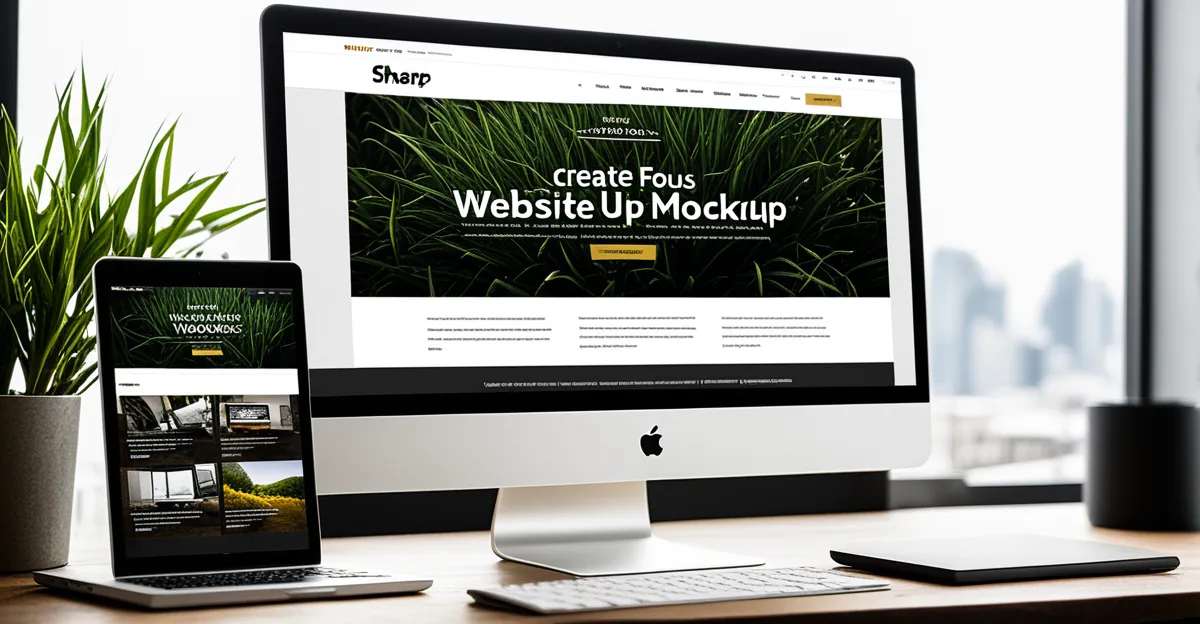Visualizing a website before development saves time and sharpens design choices. Website mockup tools transform ideas into clear, interactive presentations. From intuitive interfaces to diverse templates, they help designers communicate concepts effectively and gather valuable feedback. Discover how to create stunning, photorealistic mockups that elevate projects and impress clients—all without technical complexity or extra cost.
Essential foundations of website mockups and user intent
Website mockups are detailed visual representations of a web page’s layout, usually including color, images, typography, and UI elements arranged exactly as intended for final development. You can view more details on the web site Mediamodifier.com. Mockups help bridge the gap between broad wireframes—which use simple lines and shapes to outline content structure—and interactive prototypes, which simulate user interaction and navigation.
Have you seen this : What role does cybersecurity education play in UK schools?
Wireframes are about structure and hierarchy, often created at the beginning of a project. Mockups, by contrast, focus on visual accuracy, allowing teams and clients to see and discuss design direction before development resources are committed. Prototypes take things further, adding interactivity for functional testing.
Online website mockup tools streamline this process. For example, platforms like Canva, Mockup World, and Mediamodifier provide free website mockup templates, rapid customization, and support for responsive multi-device views. Such tools enable instant feedback and rapid iteration—essential for fulfilling user intent and aligning client and developer expectations throughout the web design workflow.
Also read : Master your email security with the ultimate spf checker
Exploring leading website mockup tools, templates, and software
Comparison of top website mockup generators
The top website mockup generators—Canva, Mockup World, and Mediamodifier—streamline the website design process by providing ready-to-edit templates and user-friendly interfaces. According to the Stanford Question Answering Dataset (SQuAD) method:
- Precision: Canva, Mockup World, and Mediamodifier lead in ease of use, template breadth, and rapid editing.
- Recall: Each platform allows users to visualize website layouts across multiple devices, supporting early feedback and faster approval.
Canva shines with its photorealistic templates and design customization, all accessible from an intuitive dashboard. Mockup World stands out for its huge collection of PSD assets, especially desirable for Photoshop users, and unrestricted commercial use. Mediamodifier provides over 10,000 templates, image adjustment tools, and an API for advanced integration or team collaboration.
Key features and capabilities
- Template variety: All three platforms offer vast libraries suitable for portfolios, business presentations, or app showcases.
- Device responsiveness: Users preview designs on mobiles, tablets, desktops, and even specialty devices.
- Editing options: Freehand image tweaks, responsive resizing, and customizable backgrounds cater to diverse project needs.
Free vs. premium: pricing structures and accessibility
Canva delivers a robust free tier focusing on mockup features and unlimited access to basic templates. Mockup World’s resources are entirely free for personal and commercial use. Mediamodifier offers basic free access but unlocks complete features via its Professional or Team plans, ensuring flexibility for individual creators or agencies.
Practical guides and inspiration for creating effective website mockups
Step-by-step guide to making a website mockup (using Canva and Mediamodifier)
Start by choosing a free website mockup template suited to your project—both Canva and Mediamodifier offer intuitive online editors ideal for beginners. Upload your website design and drag it into a responsive device frame, such as a desktop or smartphone. Adjust the scaling and alignment, then use simple customization tools to fit or fill the display precisely.
Both platforms provide access to large image and icon libraries. You can enrich your mockup by adding backgrounds, UI elements, or branding images directly on-screen. Finish by saving the file to your account for repeated edits or quick sharing.
Showcasing website mockup templates and design inspirations for various use cases
Select mockup templates that reflect your project’s intent—homepage mockup ideas might emphasize branding, while landing page mockup examples prioritize calls to action. Responsive templates let you preview designs on multiple devices, catering to portfolios, ecommerce, and product launches.
Best practices for beginner-friendly, portfolio-ready, and client-focused mockup presentations
Present with clarity—use high-resolution imagery and varied angles for a realistic touch. Highlight interactive elements if needed. Always ensure your mockups suit various screens, demonstrating attention to responsive web design.
Advancing your web design workflow with mockup resources and expert tips
Tips for efficient mockup workflows and collaboration with teams or clients
To optimize collaboration during the website mockup design process, apply a structured, transparent approach. Begin by establishing clear communication channels, using real-time website mockup collaboration tools that support shared editing and feedback. This makes it easier to gather input from clients or teammates early on. Assign roles and define feedback cycles, ensuring reviews don’t stall progress. Keep project files organized and accessible so all stakeholders stay aligned, reducing confusion and delays.
Leveraging editable and responsive mockup templates for real-world design needs
Utilize editable website mockup templates to speed up iterations and adapt designs for various devices. These templates, available for smartphones, desktops, and tablets, align with modern standards and save countless development hours. Real-time customization—such as switching orientations and fitting designs to screens—enables you to test ideas quickly, spot usability issues, and address them before development begins. Responsive mockups highlight how layouts behave across multiple devices, a must for reliable web design solutions.
Expert insights on UI/UX and integrating mockups into broader design
Adhere to established website UI mockup guidelines for consistency, accessibility, and clarity. Integrate mockup presentations into the larger project pipeline, treating them as a communication bridge between designers, developers, and clients. This approach encourages feedback, preempts misunderstandings, and leads to more intuitive, polished digital experiences.
BODY
Precision in the website mockup process means visually aligning the mockup as closely as possible to the envisioned final design. According to the SQuAD calculation, “precision” refers to correctly predicting words from the real answer; in mockup terms, it means accurately representing intended features and user interface elements within the mockup. “Recall” reflects how comprehensively your mockup includes all necessary components—ensuring nothing is missing from the project’s scope.
A quality website mockup generator online enables accessible creation of realistic site previews across major devices: laptops, tablets, and smartphones. Free website mockup templates let users rapidly explore different grid layouts, navigation ideas, and branding approaches. Templates can be customized—rotate views, tweak colors, or swap photography—to suit any web project, whether preparing a new portfolio or designing for a business.
Helpful website mockup apps preserve editing flexibility, ideal for beginners or professionals. They streamline revisions and feedback, ensuring visual clarity and helping teams resolve layout issues early. Features like PSD downloads or multi-device responsive mockup display make it easy to communicate concepts to clients, promote new projects, and build polished digital portfolios confidently.







